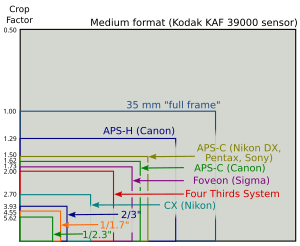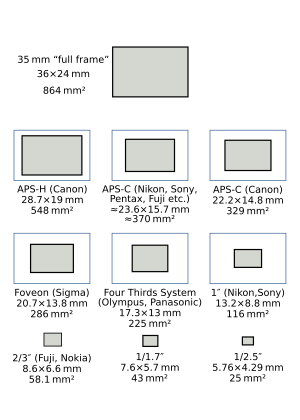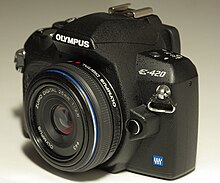
Macro photography is extreme close-up photography, usually of very small subjects and living organisms like insects, in which the size of the subject in the photograph is greater than life-size . By the original definition, a macro photograph is one in which the size of the subject on the negative or image sensor is life-size or greater. In some senses, however, it refers to a finished photograph of a subject that is greater than life-size.

The Olympus E-1, introduced in 2003, was the first DSLR system camera designed from the ground up for digital photography This contrasts with its contemporaries which offered systems based on reused parts from previous 135 film systems, modified to fit with a sensor size of APS-C.

A digital single-lens reflex camera is a digital camera that combines the optics and mechanisms of a single-lens reflex camera with a solid-state image sensor and digitally records the images from the sensor.

Sigma Corporation is a Japanese company, manufacturing cameras, lenses, flashes and other photographic accessories. All Sigma products are produced in the company's own Aizu factory in Bandai, Fukushima, Japan. Although Sigma produces several camera models, the company is best known for producing high-quality lenses and other accessories that are compatible with the cameras produced by other companies.

Advanced Photo System type-C (APS-C) is an image sensor format approximately equivalent in size to the Advanced Photo System film negative in its C ("Classic") format, of 25.1×16.7 mm, an aspect ratio of 3:2 and Ø 30.15 mm field diameter. It is therefore also equivalent in size to the Super 35 motion picture film format, which has the dimensions of 24.89 mm × 18.66 mm and Ø 31.11 mm field diameter.
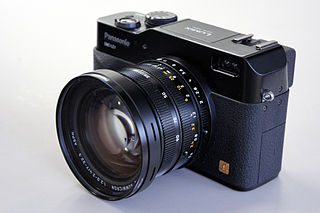
Lumix is Panasonic's brand of digital cameras, ranging from pocket point-and-shoot models to digital SLRs.

The Lumix DMC-L1 is Panasonic's first DSLR camera, and was announced in February 2006. This camera adheres to the Four Thirds System lens mount standard, making it the first non-Olympus Four Thirds camera, and thus confirming that the Four Thirds System is a semi-open standard such that compatible camera bodies can be built by different companies.

A dust reduction system, or dust removal system, is used in several makes of digital cameras to remove dust from the image sensor. Every time lenses are changed, dust may enter the camera body and settle on the image sensor.

This article details lensesfor single-lens reflex and digital single-lens reflex cameras. The emphasis is on modern lenses for 35 mm film SLRs and for "full-frame" DSLRs with sensor sizes less than or equal to 35 mm.

The Micro Four Thirds system is a standard released by Olympus Imaging Corporation and Panasonic in 2008, for the design and development of mirrorless interchangeable lens digital cameras, camcorders and lenses. Camera bodies are available from Blackmagic, DJI, JVC, Kodak, Olympus, OM System, Panasonic, Sharp, and Xiaomi. MFT lenses are produced by Cosina Voigtländer, Kowa, Kodak, Mitakon, Olympus, Panasonic, Samyang, Sharp, Sigma, SLR Magic, Tamron, Tokina, TTArtisan, Veydra, Xiaomi, Laowa, Yongnuo, Zonlai, Lensbaby, Venus Optics and 7artisans amongst others.

The Panasonic Lumix DMC-G1 was the first digital mirrorless interchangeable-lens camera (MILC) adhering to the Micro Four Thirds system design standard. The G1 camera is similar to the larger Four Thirds system format DSLR cameras, but replaces the complex optical path needed for the optical viewfinder with an electronic viewfinder EVF displaying a live view image directly from the sensor. Eliminating the mirror box and optical viewfinder allows for smaller and lighter camera bodies, while the less complex optical path also allows for smaller, lighter lens designs.

The Olympus Pen E-P1 announced on 16 June 2009 is Olympus Corporation's first camera that adheres to the Micro Four Thirds (MFT) system design standard. The first camera to use the Micro Four Thirds mount was Panasonic's G-1 camera.

A mirrorless camera is a digital camera which, in contrast to DSLRs, does not use a mirror in order to ensure that the image presented to the photographer through the viewfinder is identical to that taken by the camera. They have come to replace DSLRs, which have historically dominated interchangeable lens cameras. Other terms include electronic viewfinder interchangeable lens (EVIL) cameras and compact system cameras (CSCs).
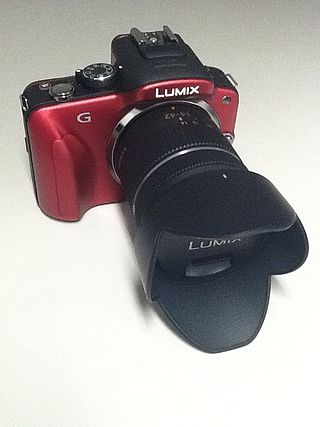
The Panasonic Lumix DMC-G3 is a digital mirrorless interchangeable lens camera adhering to the joint Olympus and Panasonic Micro Four Thirds System (MFT) system design standard. The Panasonic Lumix DMC-G3 is the eighth Panasonic MFT camera introduced under the standard and the thirteenth model MFT camera introduced by either Olympus or Panasonic, as of the G3 product announcement date.

The Panasonic Lumix G 14mm F2.5 lens is a pancake-style prime lens for Micro Four Thirds system cameras. In the Micro Four Thirds format, it is moderately wide. As of its late-2010 release, it is claimed by Panasonic to be the lightest interchangeable digital-camera lens. It is the prime-lens option available with the Panasonic GF2 and GF3, and available separately.
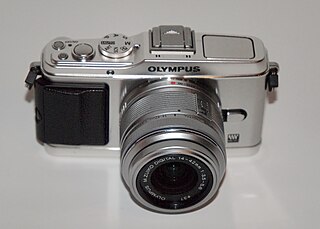
The Olympus PEN E-P3 announced on 30 June 2011 is Olympus Corporation's seventh camera that adheres to the Micro Four Thirds (MFT) system design standard. The E-P3 succeeds the Olympus PEN E-P2, and was announced in concert with two other models, the Olympus PEN E-PL3, and the Olympus PEN E-PM1.

Panasonic Lumix DMC-GF3 is the eighth camera in Panasonic's Lumix G-series adhering to the Micro Four Thirds System (MFT) design standard, and was announced in June 2011.

The Panasonic Leica D Vario-Elmarit 14-50mm F2.8-3.5 ASPH Mega OIS is an interchangeable camera lens announced by Panasonic on February 26, 2006. It was the first Leica lens with optical image stabilisation.

The Olympus Zuiko Digital ED 50-200mm F2.8-3.5 is an interchangeable lens for Four Thirds system digital single-lens reflex cameras announced by Olympus Corporation during the system launch on June 24, 2003. The SWD version is equipped with an ultrasonic motor for focusing, and was introduced in 2007 with the Olympus E-3.


